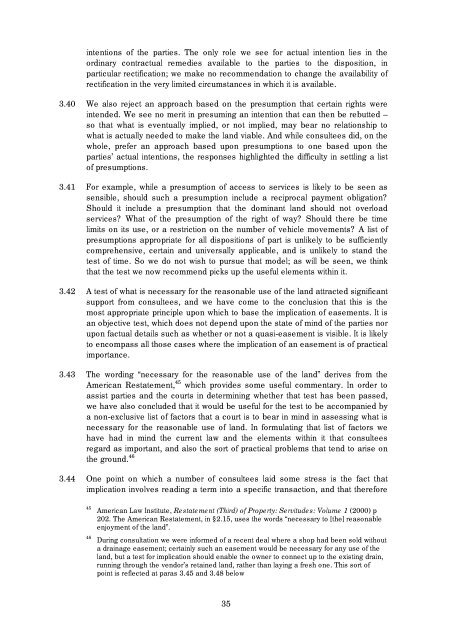Making Land Work: Easements, Covenants and ... - Law Commission
Making Land Work: Easements, Covenants and ... - Law Commission
Making Land Work: Easements, Covenants and ... - Law Commission
You also want an ePaper? Increase the reach of your titles
YUMPU automatically turns print PDFs into web optimized ePapers that Google loves.
intentions of the parties. The only role we see for actual intention lies in the<br />
ordinary contractual remedies available to the parties to the disposition, in<br />
particular rectification; we make no recommendation to change the availability of<br />
rectification in the very limited circumstances in which it is available.<br />
3.40 We also reject an approach based on the presumption that certain rights were<br />
intended. We see no merit in presuming an intention that can then be rebutted –<br />
so that what is eventually implied, or not implied, may bear no relationship to<br />
what is actually needed to make the l<strong>and</strong> viable. And while consultees did, on the<br />
whole, prefer an approach based upon presumptions to one based upon the<br />
parties’ actual intentions, the responses highlighted the difficulty in settling a list<br />
of presumptions.<br />
3.41 For example, while a presumption of access to services is likely to be seen as<br />
sensible, should such a presumption include a reciprocal payment obligation?<br />
Should it include a presumption that the dominant l<strong>and</strong> should not overload<br />
services? What of the presumption of the right of way? Should there be time<br />
limits on its use, or a restriction on the number of vehicle movements? A list of<br />
presumptions appropriate for all dispositions of part is unlikely to be sufficiently<br />
comprehensive, certain <strong>and</strong> universally applicable, <strong>and</strong> is unlikely to st<strong>and</strong> the<br />
test of time. So we do not wish to pursue that model; as will be seen, we think<br />
that the test we now recommend picks up the useful elements within it.<br />
3.42 A test of what is necessary for the reasonable use of the l<strong>and</strong> attracted significant<br />
support from consultees, <strong>and</strong> we have come to the conclusion that this is the<br />
most appropriate principle upon which to base the implication of easements. It is<br />
an objective test, which does not depend upon the state of mind of the parties nor<br />
upon factual details such as whether or not a quasi-easement is visible. It is likely<br />
to encompass all those cases where the implication of an easement is of practical<br />
importance.<br />
3.43 The wording “necessary for the reasonable use of the l<strong>and</strong>” derives from the<br />
American Restatement, 45 which provides some useful commentary. In order to<br />
assist parties <strong>and</strong> the courts in determining whether that test has been passed,<br />
we have also concluded that it would be useful for the test to be accompanied by<br />
a non-exclusive list of factors that a court is to bear in mind in assessing what is<br />
necessary for the reasonable use of l<strong>and</strong>. In formulating that list of factors we<br />
have had in mind the current law <strong>and</strong> the elements within it that consultees<br />
regard as important, <strong>and</strong> also the sort of practical problems that tend to arise on<br />
the ground. 46<br />
3.44 One point on which a number of consultees laid some stress is the fact that<br />
implication involves reading a term into a specific transaction, <strong>and</strong> that therefore<br />
45 American <strong>Law</strong> Institute, Restatement (Third) of Property: Servitudes: Volume 1 (2000) p<br />
202. The American Restatement, in §2.15, uses the words “necessary to [the] reasonable<br />
enjoyment of the l<strong>and</strong>”.<br />
46 During consultation we were informed of a recent deal where a shop had been sold without<br />
a drainage easement; certainly such an easement would be necessary for any use of the<br />
l<strong>and</strong>, but a test for implication should enable the owner to connect up to the existing drain,<br />
running through the vendor’s retained l<strong>and</strong>, rather than laying a fresh one. This sort of<br />
point is reflected at paras 3.45 <strong>and</strong> 3.48 below<br />
35
















